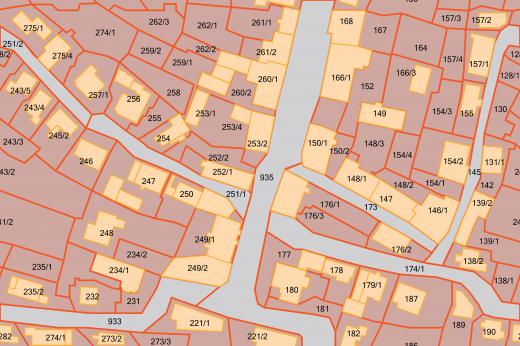What is a Cadastral Map?
 Mary McMahon
Mary McMahon
A cadastral map is a map which provides detailed information about real property within a specific area. A simple example of a cadastral map might be a map of a village which shows the boundaries of all of the parcels or lots within the village, although cadastral maps can show other types of areas as well. These maps are usually maintained by the government, and they are a matter of public record; anyone who wishes to go to the office which maintains the records can ask to see them.
Also known as a cadaster or cadastre, a cadastral map can include a number of details, including information about tax rates, who owns the land, which kinds of structures are present, what the zoning is in the region, and so forth. All of this information is intended to contexualize the area of the map by providing the viewers with as much data as possible about the land.

One key feature of a cadastral map is that it carries detailed information about location. These maps do not just show the boundaries of lot lines, they provide measurements on each lot, and may use GPS locations as well, so that people clearly understand where everything on the map is in the real world. A cadastral map will also highlight specific landmarks which people can use to orient themselves within the map, including buildings and natural features such as lakes and streams.
The map also provides people with information about property rights, and a history of the rights in that area. Cadastral maps can show who retains mining or timber rights, for example, in contrast with who owns the land. The map can also provide a history of the owners, or a perusal through old maps can provide people with this information. Maps can also detail how the land is being used, so that people interested in land use patterns can easily identify areas of interest.
These maps are updated on a regular basis. It is a good idea to keep track of the cadastral survey, as information can change. Property owners would also do well to hire a surveyor to confirm that their property adheres to the information on the maps. If, for example, a neighbor moves a fence, it could cut into a property owner's lot, and if the situation is not recognized and addresses, in some communities, the neighbor would get to keep the land annexed by the fence after a certain period of time has elapsed.
AS FEATURED ON:
AS FEATURED ON:











Discussion Comments
A friend of mine got a temporary job updating the cadastral maps in his state. He took the job because it paid very well, and I don't think he knew what all he would be getting into at first.
He had to compare current data with old records, and he had to do a lot of research. He worked long hours doing tedious work, though the product of his labor was valuable to many people.
Before he took that job, I never even knew that cadastral maps existed. Now, I'm intrigued by them, because I know the vast amount of details that they contain.
This article is very helpful and I used this for my geography assignment.
Post your comments